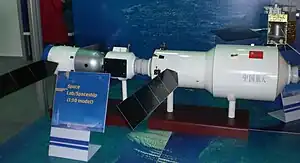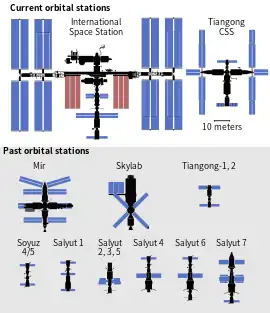Tiangong-3
Tiangong-3 (Chinese: 天宫三号; pinyin: Tiāngōng sānhào; lit. 'Heavenly Palace 3') was a proposed Chinese space station, part of the Tiangong program. The China National Space Agency (CNSA) was originally expected to launch Tiangong-3 around 2015, following the launch of the Tiangong-2 test laboratory, originally planned for 2013.[2] The goals for the Tiangong-2 and Tiangong-3 laboratories were merged, and the latter was therefore not ordered.[3][1] The first module of the third station of the Tiangong program, Tiangong space station, was eventually launched in 2021.
 | |
| Station statistics | |
|---|---|
| Crew | 3 |
| Mission status | Cancelled[1] |
| Mass | 22,000 kilograms (49,000 lb) |
| Length | 18.1 meters (59 ft) |
| Diameter | 4.2 meters (14 ft) |
Development
In 2008, the China Manned Space Engineering Office (CMSEO) published a brief description of Tiangong-2 and Tiangong-3, indicating that several crewed spaceships would be launched in the late 2010s to dock with Tiangong-3.[4] The first Tiangong module, Tiangong-1, was launched in September 2011 and docked with the uncrewed Shenzhou 8 spacecraft in November 2011, marking China's first orbital docking.[5]
Specifications
Tiangong-3 was expected to provide:
- Unaided 40-day habitability for three astronauts.[2]
- Testing for regenerative life-support technology, and verification of methods of orbital replenishment of propellant and air.[2]
- A multi-docking berthing mechanism,[6] allowing up to two spacecraft to dock with it simultaneously.
References
- ""天宫二号"总设计师:不再有天宫三号 五年后建成空间站". 2017-11-22.
"天宫二号"后,不再开发"天宫三号",中国将直接进入空间站时代,空间站预计2022年建成 (After "Tiangong-2", no longer develop "Tiangong-3", China will directly enter the era of space station, the space station is expected to be completed in 2022)
- David, Leonard (2011-03-11). "China Details Ambitious Space Station Goals". SPACE.com. Retrieved 2011-03-09.
China is ready to carry out a multiphase construction program that leads to the large space station around 2020. As a prelude to building that facility, China is set to loft the Tiangong-1 module this year as a platform to help master key rendezvous and docking technologies.
- "脚踏实地,仰望星空—访中国载人航天工程总设计师周建平". Chinese Government. Retrieved 2017-04-22.
- "future plan of space laboratory system (in Chinese)". 2008-09-29. Archived from the original on September 28, 2008.
{{cite web}}: CS1 maint: unfit URL (link) - "Chinese spacecraft dock in orbit". BBC News, 2011-11-02.
- Branigan, Tania; Sample, Ian (2011-04-26). "China unveils rival to International Space Station". The Guardian. London. Retrieved 2011-04-27.
China often chooses poetic names for its space projects, such as Chang'e – after the moon goddess – for its lunar probes; its rocket series, however, is named Long March, in tribute to communist history. The space station project is currently referred to as Tiangong, or "heavenly palace".
